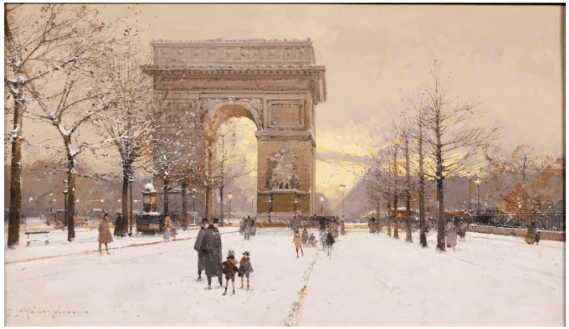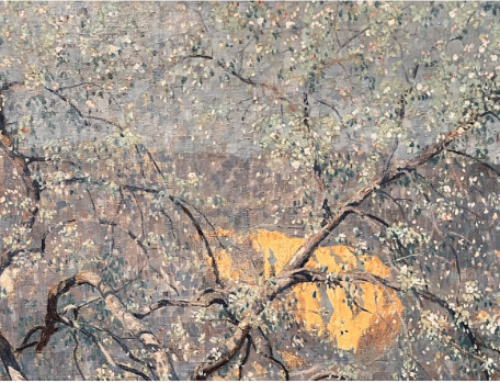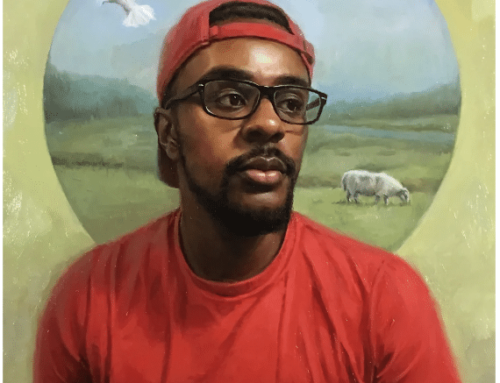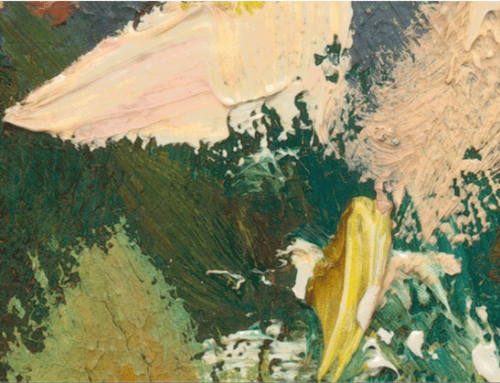For their own reasons, some artists or writers disguise their work with a pseudonym. Most of the time, it’s a made-up name, not one “borrowed” from a real person. This artist was different.
French realist Eugène Galien-Laloue (1854 – 1941) was particularly prolific in this regard – over the course of his career, he worked under three pseudonyms (that we know of): J. Lievin – after a soldier he met during the Franco-Prussian war, E. Galiany – an ”Italianized” version of his own name(s), and L. Dupuy – after Dupuy Léon who lived nearby.
“While these are three confirmed names that he used, there is the possibility that he used other names as well,” says the gallery that represents him in the U.S. “Even his name ‘Galien’ is questionable, since on occasion he spelled it with one “l” and on his birth certificate it is spelled “Gallien,”
Notoriously reclusive, Eugene Gallien-Laloue may have been hiding behind assumed names, but his paintings of turn-of-the-century Paris streets are straightforward, faultlessly drafted, and charming in their own right. They offer a record of the City of Light at the late nineteenth and early twentieth century, focusing not so much on the relationship between its citizens, but more so on the architectural aspects of the city, often in the warm glow of evening.
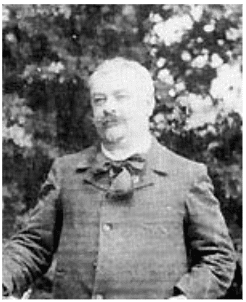
Eugene Gallien-Lalue, aka J. Levin, aka, E. Galliani, aka L. Dupuy. “Just Eugene to you.”
The First Name-Fake
In 1870, when Eugene was 16 his father died, and straightaway his mother put him to work, finding Eugene a desk job with a notary. He had to leave school to fill the position. Resentful maybe, yearning for a more adventurous life perhaps, he quit and, faking his name, joined the army. He was always a patriotic Frenchman, and so he went off to fight in the Franco-Prussian war.
WHO KNOWS what happened to him there, but by the time the war ended in 1871, he had decided to become a painter. Biographers wonder if it wasn’t “a reaction against the bloody events of the Franco-Prussian war; a way to forget what he had seen.” At any rate, by 1874 he was employed by the French Railway lines as an illustrator, depicting the rail track that was being laid from Paris to the provinces. And there he began painting the surrounding landscapes and never stopped, eventually becoming the notoriously reclusive master of the c. 1900 urban mis en scene.
He exhibited for the first time in 1876 at the Museum of Reims, showing Le quai aux fleurs par la neige (Flower Market Along the Seine Under the Snow). The following year he exhibited for the first time at the annual Parisian Salon, showing En Normandie (In Normandy) as well as two gouaches. He preferred executing gouaches since they were less time consuming than oils and at that time, they brought comparable prices.
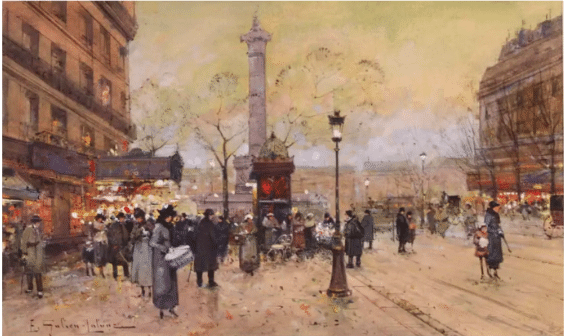
Eugene Galien-Laloue, Place Vendome, oil on canvas, 19.375 x 25.625 in.
preferred the solitariness of his studio and thus did not paint his works entirely on-site. Unlike many other artists as well, he did not like to travel and many of his views of other cities or countries were inspired by postcards and photographs, an increasing tendency with many artists as photography became a more established method of use. Noë Willer further elaborates upon the unique personality of this artist (pg. 16):
He was not eccentric but always conservative, practically a royalist. He was obsessed with his painting.
He married the girl next door – three times in a row. That is, in keeping with his preference for simplicity, he married three sisters, one after the other (beginning with the youngest and ending with the oldest), all of whom lived next door to him. By all accounts, he lived a monastic life; all worldly pursuits, games, alcohol, the pleasure of the flesh were not for him. Riding his bicycle to places in Paris to paint was his only physical exercise.
He was, however, concerned with the sale of his paintings, of which he kept scrupulous notes (though he still sold each painting for the same price). He was an active participant in the annual Parisian Salons until 1889 where he exhibited two gouaches Bernay (Bernay), and Bords de la Meuse (Banks of the Meuse). He took a five-year sabbatical, during which time a daughter was born, then returned to his urban landscapes.
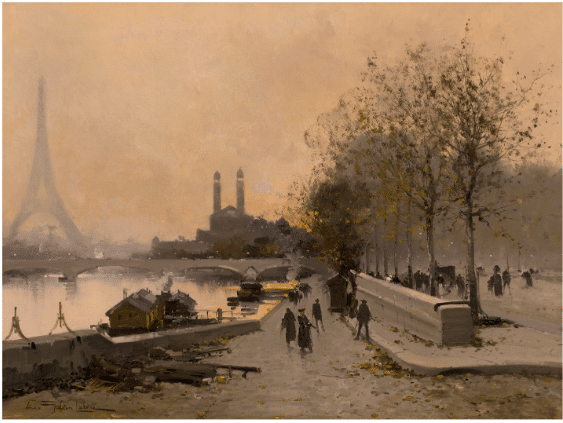
Eugene Galien-Laloue, Eugene Along the Seine: Palais du Trocadéro & Tour Eiffel
He moved out of Paris many times to depict the landscapes of Normandy and the surroundings of Barbizon, making his home for a short time in Fontainebleau. But he always returned to Paris, his city. During the first two decades of the twentieth century he exhibited at Dijon, Orléans, Versailles, Roubaix, Saint Etienne, Bordeaux, Monte Carlo, Hautecoeur, among several other cities.
As World War I broke out, he was exempt from military service, first because he’d volunteered for that earlier tour of duty during the Franco-Prussian war, and secondly because he was too old. Undaunted, he took to his canvas and depicted scenes of soldiers in battle, paying close attention to the setting and other details such as their costumes and the action of their involvement, all of which he knew well from experience.
He continued to paint until 1940, when he broke the arm with which he held his brush. By then, he had become very popular with both French and especially American artists and continued to paint the same scenes of Paris throughout his career. He died in his daughter’s house in Chérence, where they had taken refuge at the beginning of the Second World War, on April 18th, 1941.

